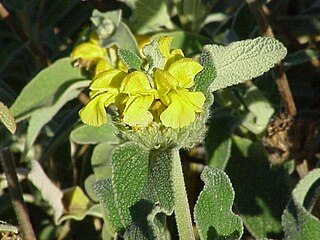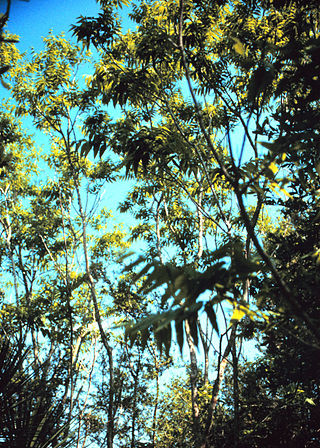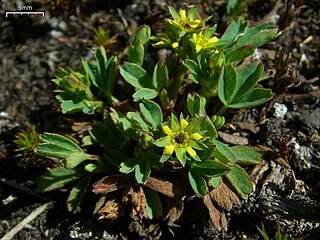
Saccharum is a genus of tall perennial plants of the broomsedge tribe within the grass family.

Phlomis is a genus of over 100 species of herbaceous plants, subshrubs and shrubs in the family Lamiaceae, native from the Mediterranean region east across central Asia to China.

Cyperus is a large genus of about 700 species of sedges, distributed throughout all continents in both tropical and temperate regions.

Inula is a genus of about 80 species of flowering plants in the family Asteraceae, native to Europe, Asia and Africa.

Sapindus is a genus of about thirteen species of shrubs and small trees in the lychee family, Sapindaceae and tribe Sapindeae. It is native to warm temperate to tropical regions of the world. The genus includes both deciduous and evergreen species. Members of the genus are commonly known as soapberries or soapnuts because the fruit pulp is used to make soap. The generic name is derived from the Latin words sapo, meaning "soap", and indicus, meaning "of India".

Stewart's wilt is a bacterial disease of corn caused by the bacterium Pantoea stewartii. The disease is also known as bacterial wilt or bacterial leaf blight and has been shown to be quite problematic in sweet corn. The causal organism is a facultatively anaerobic, gram-negative, rod-shaped bacterium. The disease is endemic in the mid-Atlantic and Ohio River Valley regions and in the southern portion of the Corn Belt. Stewart's Wilt causes minor reductions in field corn yield, despite common occurrence, because most hybrids grown in the Midwest have adequate resistance. However, the disease can be problematic in seed production because many countries have restrictions on maize seed from areas where the Stewart's Wilt occurs.
Pantoea stewartii is a species of plant pathogenic bacteria that causes Stewart's wilt of corn, as well as jackfruit-bronzing disease, bacterial leaf wilt of sugarcane, and leaf blight in rice. P. stewartii is a gram-negative bacterium in the Enterobacterales, a group that also includes Escherichia coli and several other human, animal, and plant pathogens. Most research on this bacterial pathogen to date has been done on strains infecting corn as the other diseases have been identified much more recently. Due to being relatively easy to work with in laboratory research, P. stewartii has been used to study a range of processes in bacterial physiology including quorum sensing, bacterial pigment production, endoglucanase enzymes, and siderophore-mediated iron acquisition.

Coprosma is a genus of flowering plants in the family Rubiaceae. It is found in New Zealand, Hawaiian Islands, Borneo, Java, New Guinea, islands of the Pacific Ocean to Australia and the Juan Fernández Islands.

Coriaria is the sole genus in the family Coriariaceae, which was described by Linnaeus in 1753. It includes 14 species of small trees, shrubs and subshrubs, with a widespread but disjunct distribution across warm temperate regions of the world, occurring as far apart as the Mediterranean region, southern and eastern Asia, New Zealand, the Pacific Ocean islands, and Central and South America.

Gnaphalium is a genus of flowering plants in the family Asteraceae, commonly called cudweeds. They are widespread and common in temperate regions, although some are found on tropical mountains or in the subtropical regions of the world.

Diploglottis is a genus of 11 species in the lychee and maple family Sapindaceae. Most species only occur in the Wet Tropics bioregion of Queensland, but all species except one are endemic to eastern Australia, with the exception being D. diphyllostegia, which also occurs in New Guinea. They are commonly called tamarinds, for example northern tamarind, Babinda tamarind and Bernie's tamarind, however they are not closely related to the true tamarind from the family Fabaceae.

Aerva is a genus of plants in the family Amaranthaceae. Its species are native to the palaeotropics, throughout continental Africa, Madagascar and smaller islands, through parts of the Middle East, India, and southeast Asia. Aerva javanica is an alien in northern Australia.

Euroschinus falcatus is a large tree in the mango and cashew family Anacardiaceae, found along almost the entire east coast of Australia from Cape York Peninsula to Jervis Bay. Common names include blush cudgerie and maiden's blush.

Scleranthus, the knawels, are a genus of herbaceous plants in the family Caryophyllaceae. It includes 12 species native to Europe, Siberia, western Asia, north Africa, Ethiopia, New Guinea, and Australia.
Velleia is a historically recognised genus of about 30 species of herbs in the family Goodeniaceae.

Nymphaea nouchali, often known by its synonym Nymphaea stellata, or by common names blue lotus, star lotus, red water lily, dwarf aquarium lily, blue water lily, blue star water lily or manel flower, is a water lily of genus Nymphaea. It is native to southern and eastern parts of Asia, and is the national flower of Bangladesh and Sri Lanka. In Sanskrit it is called utpala. This species is usually considered to include the blue Egyptian lotus N. nouchali var. caerulea. In the past, taxonomic confusion has occurred, with the name Nymphaea nouchali incorrectly applied to Nymphaea pubescens.

Sibbaldia is a genus of flowering plants of the family Rosaceae, with a circumpolar distribution, including the high Arctic. The type species is Sibbaldia procumbens. It is also in the Rosoideae subfamily.
Hieracium stewartii is a species of flowering plant belonging to the family Asteraceae.
Haematostaphis barteri is a species of flowering plant belonging to the family Anacardiaceae. It is a tree which ranges from western Tropical Africa to Sudan. It is the sole species in genus Haematostaphis.
Melanoseris is a genus of flowering plants belonging to the family Asteraceae.














